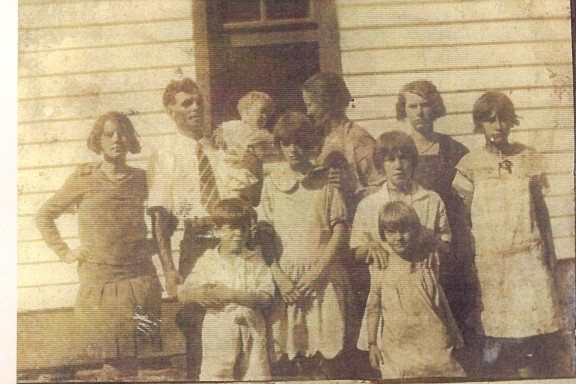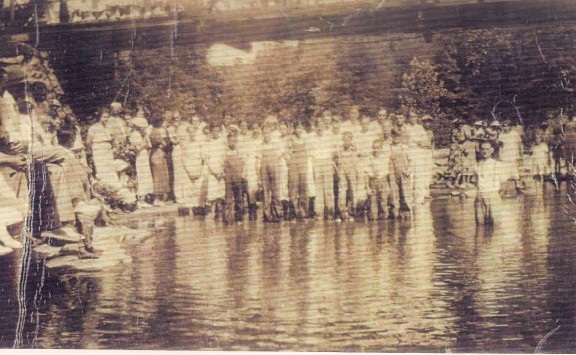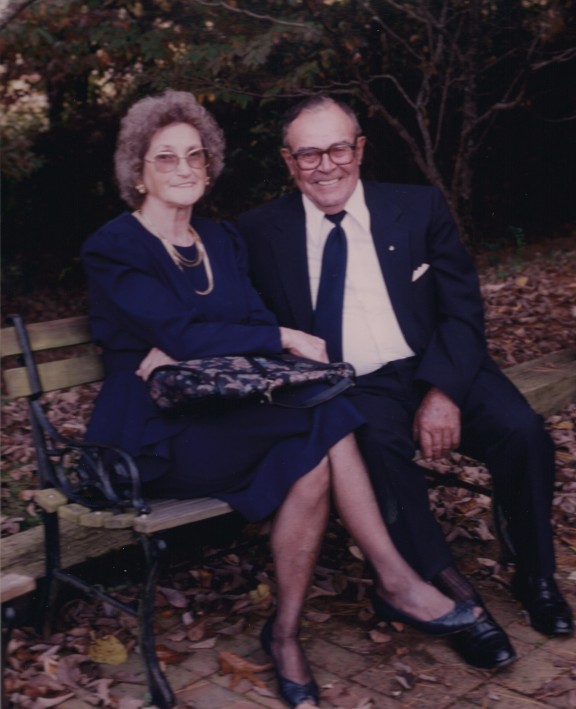|
Her Mother Was A Peddler |
|
The family of Harrison and Ursula Norrod are as follows: Back row: Geneva; Harrison Norrod holding Bill Thomas; Ursula Norrod; Edith; and Nell. Front row: Charles H; Hilda; Mildred with hands resting on the shoulders of Lois. |
|
When members of the 1989 graduating class at Livingston Academy walked down the aisle to get a diploma for completing twelve years of schooling, there was one among them that night hardly anyone in that particular class knew. In fact, some of those graduating were overheard asking each other, "Who is that old woman anyway, and what’s she doing in a cap and gown?" Those questions were answered when an announcement was made toward the end of the program that, along with the presentation of diplomas for the 1989 graduates, Mrs. Lois O. Brown, age 64, would be receiving her GED diploma. But that wasn’t the only acknowledgment Lois received that night. Those in attendance gave her a well deserved standing ovation as she walked down to get her diploma. Here is a look back at the early life of Lois Ovoca Norrod Brown. Born as the ninth child of eleven children, Lois was the daughter of Harrison Norrod and wife Ursula Florence Speck. The Norrod home was on Indian Creek in Norrod Hollow. Dr. P.A. Ogle, who was blind, but practiced medicine with the assistance of his wife, helped deliver Lois. The children in the family in the order of their births included Eskiel; Frederick; Edith; Geneva; Amelia Nell; Hilda, Mildred V.; Charles Harrison; Lois; Lilly Mae; and Bill Thomas. Lois described their family as being poor people who made a living off the farm. One of the many lessons the Norrod children were taught by their father was to always be honest, and never to take anything they hadn’t paid for. While the Norrod children were growing up, their father put long days in working on the farm to support his wife and children, while Lois’ mother drove a rubber tire wagon pulled by mules and peddled produce and other goods at Wilder. A tarpaulin served as a cover for the wagon. In cold weather, smoothing irons were heated on the wood cook stove and then wrapped in newspapers for the children to put their feet on in order to try and keep warm. The mules knew the road by heart and hardly ever was it necessary for anyone to steer them. Should they ever meet an automobile on the road, the mules knew to get over. In the summer months, the wagon was loaded with fresh vegetables to sell, along with butter and milk. Butter would be wrapped in wax paper and cold, wet cloths placed around them to keep them cool. On mornings that the family went peddling, they got out of bed around 2:30 a.m., milked five cows, and strained the milk that was placed in jugs to be taken along to sell. Butter was also churned before the journey began. In the fall, sweet potatoes and Irish potatoes were sold. When all the larger sweet potatoes were all gone, the smaller ones were canned and sold. The Norrod children always celebrated the Fourth of July by going out to pick blackberries. They never knew any other kind of celebration for this holiday. Thanksgiving was hog killing time. When a calf was killed, most of the beef was usually sold to Hack Roberts and Herbert Patterson who ran the Davidson Mercantile business. In the winter months, canned goods were sold from the peddler wagon. During the period of time the workers were on strike at the coal mines around Wilder, a threatening letter came to Lois’ mother advising her not to come to Wilder peddling her wares anymore. But she paid no attention to the letter and continued to travel there. Much of the time, Ursula Norrod was paid in what was know as "scrip," which was certificate of money for a bank or company which allowed the holder to cash it in for credit. Ursula never used a pattern to make the dresses for her daughters. She had them pick out something they liked in a Sears and Roebuck catalogue and from that picture, made their dresses. When Lois was just thirteen years old, she got her first job working at the Commissary in Wilder. She was hired by "Pa" Evans for $1.98 per day, and the first money she earned went toward the payment of a debt her mother owed. After the outstanding bill was paid, the amount Lois received was $6.13. Lois caught a ride to the Commissary each morning, but walked six miles back to her home each night. Her lunch was included in the job and it usually consisted of a grilled ham and cheese sandwich, a Snowball cake, and a coke, all for the price of twenty-five cents.
|
|
A 1936 photograph taken at Bailer Padgett's dam below the Love Joy Bridge. Thirty-seven people were baptized that day. Lois Brown was in that number. |
|
Lois attended primmer at Crawford, and then completed the remaining seven grades at Hanging Limb. She was able to attend half a year of high school at Alpine, but had to drop out so that she could care for her mother who was not in good health at that time. It was during a visit at a cousin’s home that she met Earl (Shorty) Brown, and in January of 1940, they eloped to Livingston to get married. The ceremony was performed by Justice of the Peace Arlie Hodges at Bush’s Radio Shop on South Church Street in Livingston. There was an eighteen inch snow on the ground that day, and the temperature was a mere eighteen degrees below zero. Lois was sixteen years old and Shorty was nineteen. The newly weds made their first home with her parents so that Lois could continue to care for her mother. The following spring, they moved into a home known as the Noah Baldwin place located in the Windletown community. In the early days of their marriage, and in order to obtain some canning jars, Lois once canned beans in a lard can outside for a lady named Mae Cravens. In exchange for twelve jars filled with green beans, Mrs. Cravens paid Lois with twelve empty jars. That fall, Lois and Shorty went north to find jobs, and settled in Battle Creek, Michigan. Shorty got his first job working as a bus boy in the restaurant/coffee shop called "The Buttermilk Shop." Lois went to work at "Estelle’s Cafeteria" where she was paid $12.00 a week, with $5.00 of this being taken out for food, leaving her with $7.00. The apartment she and Shorty lived in was $4.00 a week, and with the money left over, they bought groceries. The few cents left after all their expenses had been paid was saved. At that time, a loaf of bread cost five cents, and a large bag of onions could be bought for one dollar. Gas was eleven cents in Michigan, but cost seventeen cents in Tennessee. Lois would take her sewing along with her to work, and between shifts, she did mending or other sewing jobs that needed to be done. An area banker would often leave a ten cent tip, something that was considered a very large amount then, but would surely be an insult to any waitress today. Shorty taught Lois how to drive on an A Model car he owned. It’s my way of thinking that he couldn’t have chosen a worse place to teach her ... Cub Mountain. Lois told me Shorty said she ran everybody out of the road while she was learning to drive. She said she told him it could have been worse, she could have run them over one of the many steep banks along that road. Shorty and Lois left Michigan once headed back to Tennessee with nine dollars. On the way, they had car trouble and at one place in Indiana, they were told it would cost four dollars to fix the car. They didn’t want to pay that amount and continued on the journey. When they reached Bardstown, Kentucky, they were forced to get the car fixed, but were lucky enough to find a black fellow there who only charged them seventy-five cents. When they made it back to Lois’ parents’ home in Norrod Hollow, they had a total of seventy-five cents left from the nine dollars they started out with. When Lois and Shorty moved back from Michigan the first time, they moved into a rent house owned by Shorty’s uncle at Three Forks. That house had no door knobs. Grass strings were used to open and close the doors. To get into the kitchen, it was necessary to go out on the back porch. Lois kept their milk and butter in a nearby cave. By this time, Lois was expecting their first child, Larry Edward. Both she and Shorty worked for Jake Bowman hoeing out corn all day for fifty cents. Included in the day’s work was dinner that was prepared by Jake’s wife, Lora. With their earnings of one dollar per day, Lois and Shorty got paid with a bushel of shelled corn which they in turn took to the store and traded for things they couldn’t raise in the garden such as salt, sugar, and flour. The next home they lived in was back at Norrod Hollow. The house belonged to Elmer Winningham, who was married to Lois’s sister, Geneva. Their son, Larry Edward, was born there. Dr. C.A. Collins delivered him and charged a fee of $35.00. Over the course of the next several years, Shorty and Lois lived in Sulphur Springs, Florida, and later in Battle Creek, Michigan again. Just some of the jobs they had included working in a ship yard, jobs with Post Cereals, next in an airplane factory, and then later, they returned once more to Tennessee where they each found work at Ely Walker Shirt Factory in Monterey making sixty-three cents an hour. Another job Shorty had was driving a log truck. He also served a year in the U. S. Army that included a tour of duty in Japan during this period of time. Two additional children came along, Charles Douglas, born in 1944, and a daughter, Anna Jean, born in 1946. In 1959, some fourteen years later, their son, Christopher Anthony, was added to their family. It was during 1944 that Urusla Norrod opened a grocery store in Norrod Hollow. She later moved part of the store to Hanging Limb so that she could be near Lois when it came time for their daughter, Ann, to be born. Lois and Shorty eventually bought the store and moved what was left at Norrod Hollow to Hanging Limb. Lois gave me an example of how hard it was to make any money in a store. She said they had to sell at least ten cans of baking powder in order to make one penny. They ran this business for a couple of years. Then in 1960, the Browns went into business with Mr. L.G. Puckett and opened a furniture and appliance store on South Church Street in Livingston, across from the old shirt factory. They operated this business for twenty years before moving to East Main Street where they continued on for the next five years. Shorty retired after they closed this business. Lois continued to work and served as a Vista Volunteer in the Overton County Council, a job she got after obtaining her GED. She worked also in the Adult Education Literacy program for fourteen years. In 1993, Shorty died on their daughter, Ann’s, birthday at the age of 72. Lois, who at the time of this writing, is 84 years old. She continues to raise a large garden, puts up all kinds of fruits and vegetables every year, and still mows her yard. On the day I visited in her home for an interview, she was busy putting up beets, and had canned several jars of green beans the day before. She and Shorty especially enjoyed their years of active participation with the Masonic Lodge and the Eastern Star organization. Lois was recognized this past April for her fifty years of involvement with the Eastern Star chapter in Livingston. |
|
This photograph was taken of Lois and Shorty Brown not long before Shorty died.
|
|
Many folks’ homes in this area were made much more comfortable with help from Shorty and Lois Brown during the years they operated their furniture and appliance business. Credit was extended to their customers so that appliances and furniture could be bought and paid for "on time." Without this service, many families would not have been able to afford items such as a new television, an automatic washing machine, or a new stove and refrigerator. Pay day at the shirt factory was also a time customers came in to make weekly or monthly payments to the Browns. Even though Lois weighs around 96 pounds today, that same grit and determination that was necessary to go on and obtain her GED at the age of 64 is still very visible. She’s twenty years older now than she was on that occasion, but she definitely isn’t lacking in spunk and a lively spirit. She surely must have inherited most of those qualities from her mother, someone I think had to be ahead of her time. After all, running a business from a mule drawn wagon with her children along, who were all taught by both their parents to work hard at a very young age, speaks highly of the type person she was. Lois, as well as her parents, are great examples of what can be done with a positive attitude and a good outlook on life. back |


